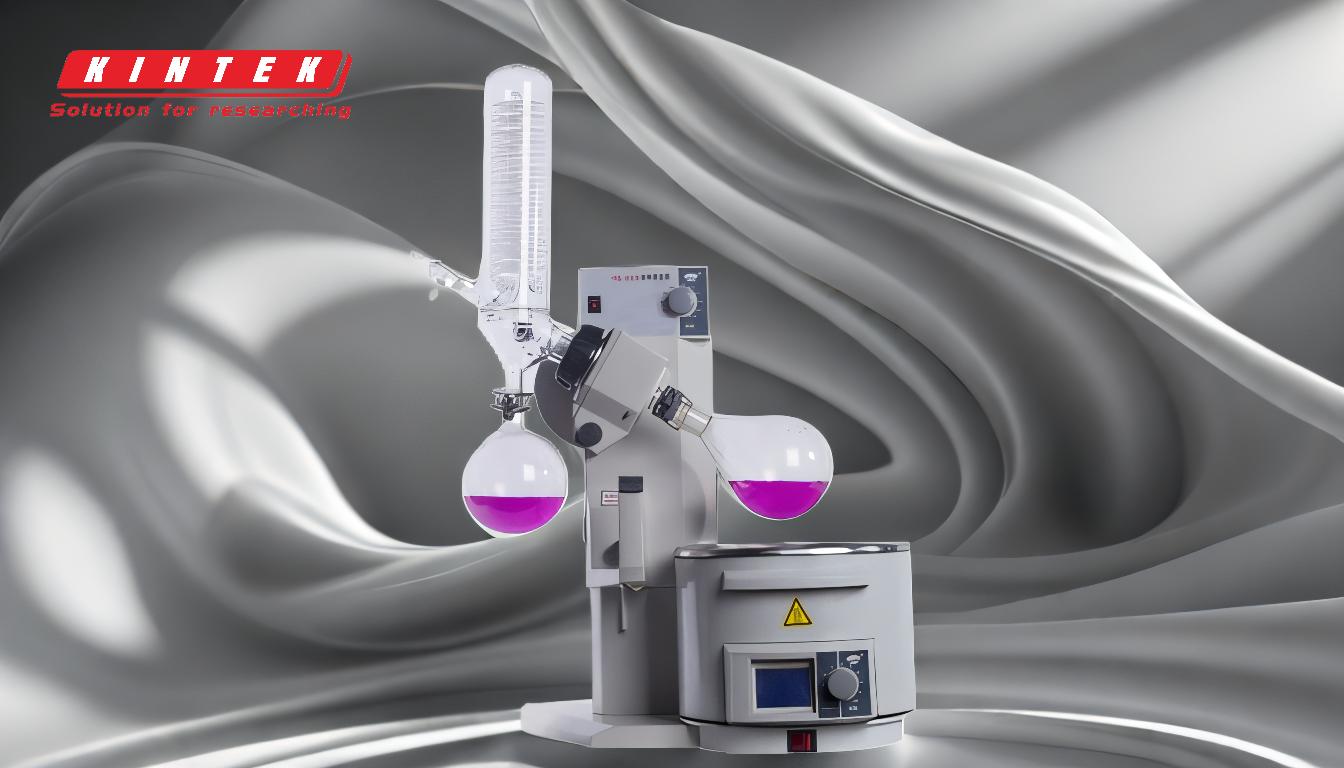The use of a vacuum in an evaporator, particularly in processes like rotary evaporation, is essential for achieving efficient and controlled solvent removal. By lowering the pressure inside the system, the boiling point of the solvent is reduced, allowing evaporation to occur at lower temperatures. This protects temperature-sensitive compounds from degradation, ensures gentle distillation, and improves the overall efficiency of the process. Additionally, the vacuum environment prevents contamination, reduces the risk of bumping, and enables precise control over the evaporation rate, making it a critical component in laboratory and industrial evaporation applications.
Key Points Explained:

-
Lowering the Boiling Point of Solvents:
- A vacuum reduces the pressure inside the evaporator, which in turn lowers the boiling point of the solvent. This allows evaporation to occur at much lower temperatures than would be possible at atmospheric pressure.
- Why it matters: Lower temperatures protect heat-sensitive compounds from degradation, preserving the integrity of the sample. This is particularly important in applications involving pharmaceuticals, food products, or delicate chemical compounds.
-
Preserving Sample Integrity:
- By enabling evaporation at reduced temperatures, a vacuum minimizes the risk of thermal degradation or unwanted chemical reactions in the sample.
- Why it matters: This ensures that the final product retains its desired properties, such as flavor, aroma, or chemical structure, which is critical in industries like food science, cosmetics, and organic chemistry.
-
Improving Process Efficiency:
- A vacuum allows for faster evaporation rates compared to heating alone, as the solvent can boil at a lower temperature. This reduces the time required for the process.
- Why it matters: Increased efficiency saves time and energy, making the process more cost-effective and scalable for industrial applications.
-
Preventing Bumping:
- Bumping occurs when a liquid boils unevenly, causing sudden and violent eruptions that can lead to sample loss or contamination. A vacuum creates a more controlled evaporation environment, reducing the likelihood of bumping.
- Why it matters: This ensures a smoother and safer evaporation process, minimizing the risk of sample loss or damage to equipment.
-
Enhancing Solvent-Product Separation:
- A vacuum helps achieve better separation of the solvent from the desired product by ensuring a more controlled and uniform evaporation process.
- Why it matters: This improves the purity and yield of the final product, which is essential in applications like chemical synthesis or solvent recovery.
-
Containing Toxic or Hazardous Fumes:
- The use of a vacuum in an enclosed system helps contain and safely remove toxic or hazardous fumes generated during evaporation.
- Why it matters: This protects laboratory personnel and the environment from exposure to harmful substances, ensuring compliance with safety regulations.
-
Enabling Precise Control:
- The vacuum level can be easily adjusted to achieve the desired evaporation rate, providing greater control over the process compared to relying solely on temperature adjustments.
- Why it matters: Precise control is crucial for optimizing the process, especially when working with complex or sensitive materials.
-
Reducing Environmental Interaction:
- A vacuum environment prevents evaporated particles from interacting with background gases, reducing the risk of contamination and ensuring the purity of the final product.
- Why it matters: This is particularly important in applications like thin-film deposition or high-purity chemical production, where even minor contamination can compromise the quality of the end product.
-
Handling High-Boiling Solvents:
- A vacuum is particularly useful for evaporating high-boiling solvents like DMSO, which would otherwise require extremely high temperatures to evaporate at atmospheric pressure.
- Why it matters: This expands the range of solvents that can be effectively processed, making the technique versatile for a wide variety of applications.
-
Preventing Undesirable Reactions:
- By removing air and other gases from the system, a vacuum minimizes the risk of oxidation or other unwanted chemical reactions during evaporation.
- Why it matters: This ensures the stability and quality of the final product, particularly in applications involving reactive or sensitive compounds.
In summary, the use of a vacuum in an evaporator is a fundamental aspect of modern evaporation techniques. It enables lower-temperature evaporation, protects sensitive materials, improves efficiency, and ensures a controlled and safe process. These benefits make vacuum-assisted evaporation indispensable in both laboratory and industrial settings.
Summary Table:
| Key Benefit | Why It Matters |
|---|---|
| Lowers boiling point of solvents | Protects heat-sensitive compounds from degradation. |
| Preserves sample integrity | Ensures final product retains desired properties like flavor or chemical structure. |
| Improves process efficiency | Reduces time and energy, making the process cost-effective. |
| Prevents bumping | Minimizes sample loss and equipment damage. |
| Enhances solvent-product separation | Improves purity and yield of the final product. |
| Contains toxic fumes | Protects personnel and the environment from harmful substances. |
| Enables precise control | Optimizes evaporation rate for complex or sensitive materials. |
| Reduces environmental interaction | Ensures purity by preventing contamination. |
| Handles high-boiling solvents | Expands the range of solvents that can be processed. |
| Prevents undesirable reactions | Maintains stability and quality of reactive compounds. |
Ready to optimize your evaporation process? Contact us today to learn more!

















